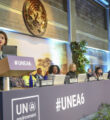Climate Change Could Force 216Mln to Migrate Within Their Own Borders by 2050: World Bank
Washington – Climate change, an increasingly potent driver of migration, could force 216 million people across six world regions to move within their countries by 2050, the World Bank’s “Groundswell” report said.
“Hotspots of internal climate migration could emerge as early as 2030 and continue to spread and intensify by 2050,” said an update of the report released Monday.
“By 2050, Sub-Saharan Africa could see as many as 86 million internal climate migrants; East Asia and the Pacific, 49 million; South Asia, 40 million; North Africa, 19 million; Latin America, 17 million; and Eastern Europe and Central Asia, 5 million.”
Even so, as much as four-fifths of the projected migration could be reduced by decisive collective action, the World Bank said.
“Immediate and concerted action to reduce global emissions, and support green, inclusive, and resilient development, could reduce the scale of climate migration by as much as 80 percent,” the report said.
Previously published studies on climate change found that 1% of the world was already a barely livable hot zone and that by 2070, that portion could increase to 19%.
“The Groundswell report is a stark reminder of the human toll of climate change, particularly on the world’s poorest — those who are contributing the least to its causes,” Juergen Voegele, World Bank’s Vice President of Sustainable Development said in the report released Monday. “It also clearly lays out a path for countries to address some of the key factors that are causing climate-driven migration.”
All the cited issues in the report were fundamentally connected and the World Bank’s response to climate change was positioned to deliver on objectives aimed at building a “more sustainable, safe and resilient future”, Voegele added.













